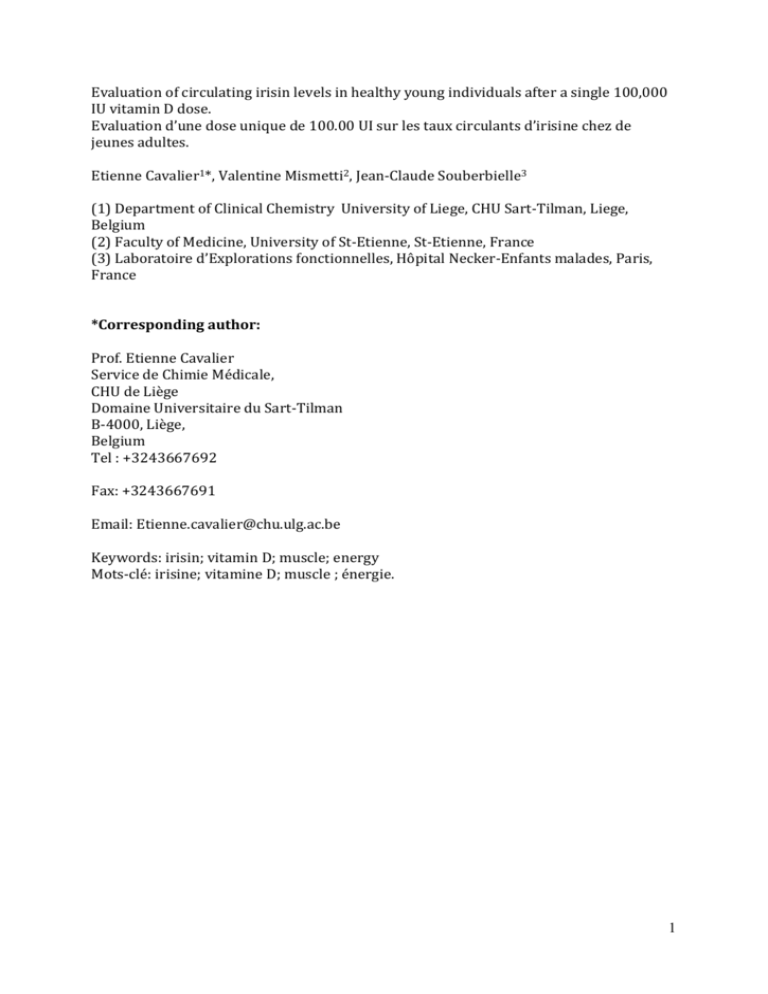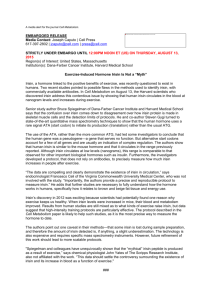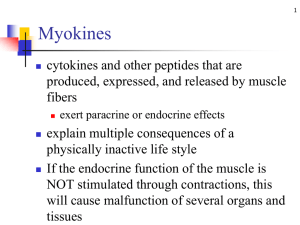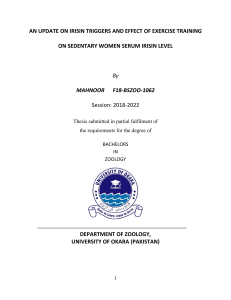Irisine_Version_4_Propre
advertisement

Evaluation of circulating irisin levels in healthy young individuals after a single 100,000 IU vitamin D dose. Evaluation d’une dose unique de 100.00 UI sur les taux circulants d’irisine chez de jeunes adultes. Etienne Cavalier1*, Valentine Mismetti2, Jean-Claude Souberbielle3 (1) Department of Clinical Chemistry University of Liege, CHU Sart-Tilman, Liege, Belgium (2) Faculty of Medicine, University of St-Etienne, St-Etienne, France (3) Laboratoire d’Explorations fonctionnelles, Hôpital Necker-Enfants malades, Paris, France *Corresponding author: Prof. Etienne Cavalier Service de Chimie Médicale, CHU de Liège Domaine Universitaire du Sart-Tilman B-4000, Liège, Belgium Tel : +3243667692 Fax: +3243667691 Email: Etienne.cavalier@chu.ulg.ac.be Keywords: irisin; vitamin D; muscle; energy Mots-clé: irisine; vitamine D; muscle ; énergie. 1 Abstract Irisin is a newly discovered hormone produced by the muscle. This hormone is involved in glucose metabolism, muscle strength and energy expenditure. As vitamin D is also known as a key player in that field, we aimed to see if a single dose of 100.00 IU of vitamin D would modify circulating levels of irisin in 29 young adults. Irisin was determined with the Phoenix Elisa assay at day 0, day 3, day 7 day 15 and day 28 after the loading dose. If we observed a significant increase in 25(OH)D levels (from 19.8±8.4 ng/mL to 33.0±8.5 ng/mL), irisin levels remained constant throughout the study (median 104.5 ng/mL, with values ranging from 69.9 to 390.9 ng/mL). Interestingly, one subject presented irisin values that were three times higher than all the others. Résumé L’irisine est une hormone produite par le muscle jouant un rôle dans la force musculaire, le métabolisme glucidique et la dépense énergétique. Comme la vitamine D est également associée aux mêmes effets, nous avons voulu évaluer l’impact d’une prise de 100,000 UI de vitamine D sur les taux circulants d’irisine de 29 sujets adultes. Nous avons dosé l’irisine avec le kit Elisa de Phoenix avant la prise et après 3, 7, 14 et 28 jours. Si les taux de25(OH)-vitamine D se sont élevés de façon significative (de 19.8±8.4 ng/mL à 33.0±8.5 ng/mL), nous n’avons pas constaté de variation du taux d’irisine (taux médian de 104.5 ng/mL, s’étalant de 69.9 à 390.9 ng/mL). Par contre, un sujet présentait de façon assez intéressante, des valeurs trois fois plus élevées que tous les autres. 2 Introduction New findings have emerged to explain the role played by physical exercise on different organs. Recently, a newly discovered hormone, named irisin, was found to be produced by the muscle after exercise and has been shown to act on white adipose cells in culture and in vivo to stimulate the expression of Uncoupling protein 1 (UCP1) expression and browning of these cells in mice [1]. Interestingly, irisin can cause an increase in energy expenditure in mice with no changes in movement or food intake, potentially resulting in improvements in obesity and glucose homeostasis. Other fields of research have also suggested that vitamin D (VTD) – alone or in combination with other factors - plays a role in weight reduction, improves the parameters of glucose metabolism and increases muscular strength [2-4]. As the expression of FNDC5, the precursor of irisin, is induced in muscle by physical exercise via a PGC1 alpha-dependent pathway and that there may be, in muscle, an interplay between the vitamin D receptor and PGC1 alpha signaling pathways [5], a link between vitamin D and irisin may be investigated, even if Choi et al have demonstrated in rats that vitamin D did not altered AMPK phosphorylation, the upstream of PGC1 alpha [6] . In this study, we aimed to see if a single supplementation of a dose of 100,000 UI of VTD in healthy individuals could have an impact of irisin circulating levels. Patients, materials and methods. This study is approved the local Ethics Committee of the University Hospital of Liège. Twenty-nine young laboratory healthy volunteers (19 females, 29 ± 8.2 years old, BMI 23.2±4.0 kg/m²) were included. A single oral dose of 100,000 IU vitamin D3 (4 vials of D-Cure each containing 25,000 IU cholecalciferol, SMB Laboratories, Belgium) was administrated to each subject at baseline. Blood was collected from fasting participants 3 at baseline, 3, 7, 15 and 28 days, aliquoted and stored at -80°C until determination. All the analytical tests were performed in the 2 months after sampling. Irisin was determined with an Elisa method (Phoenix Pharmaceuticals, Burlingame CA), 25hydroxyvitamin-D (25(OH)D) with an automated immunoanalyzer (DiaSorin Liaison, Stillwater, MN) and 1.25(OH)2 vitamin D with another automated method (IDS iSYS, Boldon, UK) according to the manufacturer’s instructions in our ISO 15189 Laboratory. We used Wilcoxon paired test to compare the results of the subjects before and after supplementation, with a p-value being considered as significant if it was <0.05. Results At baseline, median 25(OH)D values were 19.8±8.4ng/ml, rose to 29.7±9.6ng/ml at day 3 (+50%, p<0.05), reached 33.0±8.9 ng/ml at day 7 (+11%, p=0.085) and significantly decreased from day 7 to 28 (-7%, p<0.05). Before repletion, 51.7% of the participants (n=15) presented a serum 25OHD concentration ≤20 ng/ml and 27.6% (n=8) ≥30ng/ml. At days 3, 7 and 28, these values changed to 3.4% (n=1) and 48.3% (n=14), 3.4% (n=1) and 65.5% (n=19) and 3.4% (n=1) and 51.7% (n=15), respectively. Subjects with 25OHD values ≤20 ng/ml at baseline achieved significant increase of +70% (p<0.05) at day 28 while those with values >20 ng/ml presented an increase of +25% (p<0.05). 1,25(OH)2D significantly increased from 64.1±21.0 pg/ml at baseline to 82.6±26.2 pg/ml at day 3 (p<0.05). Subjects with 25OHD values ≤20 ng/ml at baseline presented a significant 1,25OHD increase at day 28 (+21%, p<0.05) whereas those with 25OHD values >20 ng/ml did not. At baseline, the median irisin values were 104.5 ng/mL, with values ranging from 69.9 to 390.9 ng/mL. There was no correlation between irisin levels and BMI. We did not observe any significant change in irisin values after 3, 7, 15 or 28 days. Interestingly, on subject presented values of approximately three times higher then the mean of the population throughout all the study (Figure 1). 4 Discussion. Irisin is a newly discovered hormone that increases muscle strength and energy expenditure. Vitamin D has also been shown to play a similar role in some [7] but not all [8] studies. In this study, we failed to show that a single large (100,000 IU) dose of vitamin D increased the circulating levels of irisin in young healthy individuals. We have however to acknowledge that our population globally did not present vitamin D deficiency (30% of them were even above 30 ng/mL) and, accordingly, it is possible that a further supplementation on the Irisin production (cleavage & release into the circulation) might have no further effect. A correlation between irisin levels and BMI has been found in severe obese patients and in patients with anorexia nervosa [9]. We did not find such a correlation, but our population was composed of young healthy young subjects presenting BMI values, ranging from 18 to 30 kg/m² explaining probably this lack of correlation. The results that we observed here were in the same range as those observed by Huh et al (113.1±20.6 ng/mL) compared to those that Stengel et al. obtained in normal weight individuals [10]. This is quite intriguing, because we used in this study the same kit as Stengel whereas Huh et al. used the Aviscera assay. To overcome a stability problem, we designed a study in which we stored 19 EDTA freshly collected samples with and without aprotinin for 1 month at -80°C. Our results show that storage at -80°C did not alter irisin concentration. Also, we did not find any difference between the samples kept with or without aprotinin. The discrepancies observed between different kits for irisin measurement have recently be highlighted by Sanchis-Gomar et al [11]. These authors clearly questioned the validation of the antibodies used in the kits, the source and nature of the antigen and even wondered if irisin really existed... 5 In conclusion, our results have shown that a single 100,000 IU dose did not impact irisin levels in non obese subjects and that the effects of vitamin D on muscle strength may not be linked to an irisin pathway. Interestingly, on subject presented irisin values that were three times higher than the others. These high values were later confirmed on another set of samples. This young lady did not present any particular characteristics even if she acknowledged having facilities in losing weight and if her father, aged 51, presented the same weight as when he was 17, even after stopping smoking. A familial and genetic study may be of interest to see if there was a link between these observations, even if circulating irisin levels seem maternally inherited [12]. Finally, irisin may be a promising hormone in the future for therapeutical or diagnostic approaches, but some issues still remain on its determination. Conflicts of interest: None to declare 6 Figure: evolution of irisin levels (ng/mL) in 29 healthy adults after a single oral dose of 100.000 IU of vitamin D Reference List 1. Bostrom P, Wu J, Jedrychowski MP et al. A PGC1-alpha-dependent myokine that drives brown-fat-like development of white fat and thermogenesis. Nature 2012; 481:463-8. 2. Holick MF. Vitamin D deficiency. N Engl J Med 2007; 357:266-81. 3. Visser M, Deeg DJ, Lips P. Low vitamin D and high parathyroid hormone levels as determinants of loss of muscle strength and muscle mass (sarcopenia): the Longitudinal Aging Study Amsterdam. J Clin Endocrinol Metab 2003; 88:5766-72. 4. Cavalier E, Delanaye P, Souberbielle JC, Radermecker RP. Vitamin D and type 2 diabetes mellitus: where do we stand? Diabetes Metab 2011; 37:265-72. 5. Savkur RS, Bramlett KS, Stayrook KR, Nagpal S, Burris TP. Coactivation of the human vitamin D receptor by the peroxisome proliferator-activated receptor gamma coactivator-1 alpha. Mol Pharmacol 2005; 68:511-7. 6. Choi M, Park H, Cho S, Lee M. Vitamin D3 supplementation modulates inflammatory responses from the muscle damage induced by high-intensity exercise in SD rats. Cytokine 2013; 63:27-35. 7 7. Muir SW, Montero-Odasso M. Effect of vitamin D supplementation on muscle strength, gait and balance in older adults: a systematic review and meta-analysis. J Am Geriatr Soc 2011; 59:2291-300. 8. Stockton KA, Mengersen K, Paratz JD, Kandiah D, Bennell KL. Effect of vitamin D supplementation on muscle strength: a systematic review and meta-analysis. Osteoporos Int 2011; 22:859-71. 9. Stengel A, Hofmann T, Goebel-Stengel M, Elbelt U, Kobelt P, Klapp BF. Circulating levels of irisin in patients with anorexia nervosa and different stages of obesity-correlation with body mass index. Peptides 2013; 39:125-30. 10. Huh JY, Panagiotou G, Mougios V et al. FNDC5 and irisin in humans: I. Predictors of circulating concentrations in serum and plasma and II. mRNA expression and circulating concentrations in response to weight loss and exercise. Metabolism 2012; 61:1725-38. 11. Sanchis-Gomar F, Alis R, Pareja-Galeano H, Romagnoli M, Perez-Quilis C. Inconsistency in Circulating Irisin Levels: What is Really Happening? Horm Metab Res 2014. 12. Al-Daghri NM, Al-Attas OS, Alokail MS et al. Maternal inheritance of circulating irisin in humans. Clin Sci (Lond) 2014. 8








